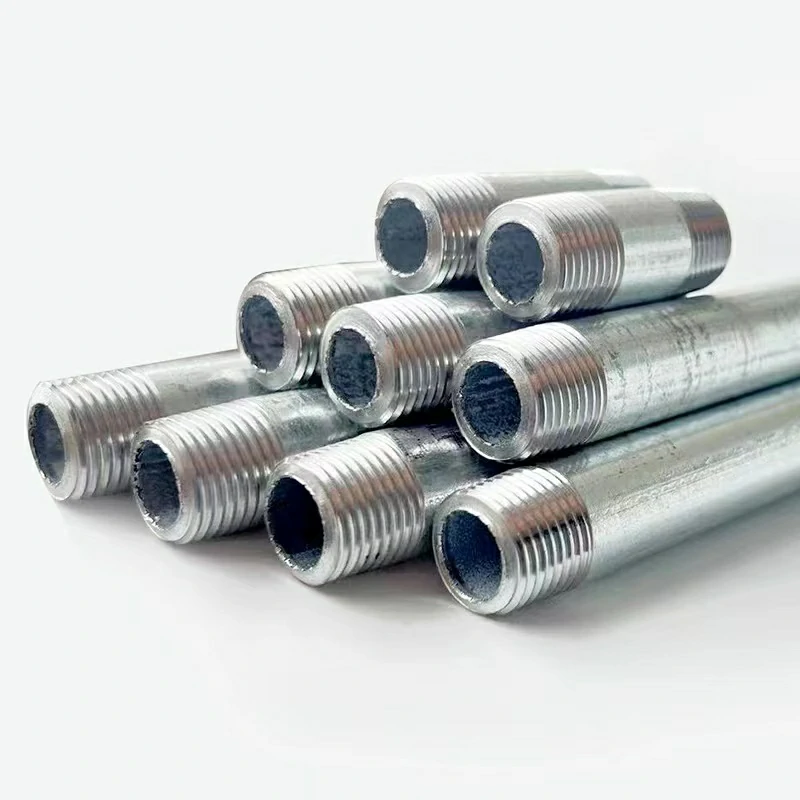Galvanized pipe nipples are commonly used in plumbing systems for their durability and resistance to corrosion.
Here’s a general overview of how galvanized pipe nipples are typically installed:
Preparation: Start by gathering all the necessary tools and materials for the installation, including the galvanized pipe nipple, pipe wrenches, Teflon tape or pipe thread sealant, and a suitable pipe joint compound if required.
Shut off the Water Supply: If the installation involves a water supply line, turn off the main water supply valve to prevent water flow during the installation process. This ensures a dry and safe working environment.
Measure and Cut the Pipe: Determine the required length of the galvanized pipe nipple based on the specific plumbing configuration. Measure and mark the pipe accordingly. Use a pipe cutter or hacksaw to cut the pipe to the desired length. Ensure that the cut is clean and free from burrs or sharp edges.
Thread the Pipe: Galvanized pipe nipples have male threads on both ends. The exposed threads should be clean and free from debris. If necessary, use a wire brush to clean the threads. Apply a suitable pipe joint compound or Teflon tape to the male threads, wrapping it in a clockwise direction. This helps create a tight seal and prevents leaks.
Connect the Pipe Nipple: Attach one end of the galvanized pipe nipple to the corresponding threaded fitting, such as a coupling or elbow. Use a pipe wrench to grip the pipe nipple securely while tightening it. Avoid over-tightening, as it can damage the threads or cause leaks.
Tighten the Connections: Use two pipe wrenches—one to hold the fitting and the other to tighten the connection. This ensures a secure and leak-free joint. Be careful not to overtighten, as it can distort or damage the pipe or fitting.
Check for Leaks: Once the galvanized pipe nipple is securely connected, open the water supply valve (if applicable) and check for any signs of leakage. Inspect the connections visually and feel for any moisture. If there are leaks, tighten the connections further or apply additional pipe joint compound or Teflon tape as needed.
Test the System: After installation, it’s important to test the plumbing system. Turn on the water supply and check for proper water flow and pressure. Monitor the system for any leaks or abnormalities.
It’s worth noting that the specific installation process may vary depending on the plumbing system and the requirements of your project. It is important to follow local plumbing codes and regulations and consult with a professional plumber if you have specific concerns or complex installations.
What are the typical sizes and dimensions available for galvanized pipe nipples?
Galvanized pipe nipples are available in a range of sizes and dimensions to accommodate various plumbing needs.
The typical sizes and dimensions of galvanized pipe nipples include:
1/8 inch (0.3175 cm) – This is the smallest size and is often used for low-flow applications or as extensions for smaller pipes.
1/4 inch (0.635 cm) – Commonly used for small-scale plumbing connections, such as residential water supply lines or applications with low water flow requirements.
3/8 inch (0.9525 cm) – Suitable for a variety of applications, including residential plumbing, irrigation systems, and smaller-scale industrial uses.
1/2 inch (1.27 cm) – One of the most common sizes, widely used in residential and commercial plumbing for water supply lines, gas lines, and general plumbing connections.
3/4 inch (1.905 cm) – Used for medium-scale plumbing applications, including residential and commercial plumbing, irrigation systems, and industrial uses.
1 inch (2.54 cm) – Frequently used in larger residential plumbing, commercial plumbing, and industrial applications that require higher water flow rates.
1 1/4 inch (3.175 cm) – Used for larger-scale plumbing projects, such as industrial plumbing systems, high-capacity water supply lines, and some commercial applications.
1 1/2 inch (3.81 cm) – Suitable for larger plumbing applications, including industrial settings, commercial buildings, and high-capacity water supply lines.
2 inches (5.08 cm) – Often used in industrial settings, commercial buildings, and large-scale plumbing projects that require substantial water flow rates.
These sizes are some of the most common ones available, but galvanized pipe nipples can be found in other sizes as well, depending on specific requirements and regional standards. It’s important to select the appropriate size based on the plumbing system’s needs, including flow rate, pressure, and the size of the existing pipes and fittings.
